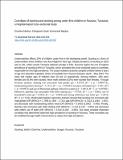Correlates of diarrhea and stunting among under-five children in Ruvuma, Tanzania; a hospital-based cross-sectional study

View/
Date
2020-07Author
Modern, Grantina
Sauli, Elingarami
Mpolya, Emmanuel
Metadata
Show full item recordAbstract
Undernutrition affects 20% of children under five in the developing world. Stunting is a form of undernutrition when children have low height for their age. Global prevalence of stunting in 2019 was 21.4%, while current Tanzania national average is 34%. Ruvuma region has one of highest prevalence of stunting (44%) in Tanzania, which prompted this cross-sectional study on correlates responsible for this high prevalence. The study included randomly sampled children below 5 years of age who attended outpatient clinics at hospitals from Ruvuma between April – May 2019. The mean and median ages of children were 18 and 13 respectively. Among children, 46% were females and 45.6% were stunted. More male children (52%) were stunted than females. Through bivariate analysis, stunting was associated with gender (χ2 = 6.6759, df = 1, p = 0.009772), handwashing before food (χ2 = 5.1213, df = 1, p = 0.02363), location of hospital (χ2 = 3.851, df = 1, p = 0.04972) and use of Municipal garbage collection system (χ2 = 3.6814, df = 1, p = 0.05502). Moreover, diarrhea was associated with toilet sharing (χ2 = 5.4703, df = 1, p = 0.002), use of household's toilet (χ2 = 4.0224, df = 1, p = 0.004) and rinsing child feces into toilet (χ2 = 3.6814, df = 1, p < 0.01). Multivariate logistic regression analyses showed that stunting risk increased with male gender (OR (95%CI) = 1.7945 (1.1944 – 2.712), age (OR (95%CI) = 1.3122 (1.1484 – 1.507), and decreased with handwashing before meal (OR (95%CI) = 0.5403 (0.3042 – 0.940). Finally, diarrhea risk increased with toilet sharing (OR (95%CI) = 2.154 (1.153 – 3.953) and decreased with child's use of toilet (OR (95%CI) = 0.510 (0.259 – 0.945). Our study revealed important correlates that determined observed high prevalence of stunting in Ruvuma. These correlates can be modified through health interventions to reduce this high prevalence.
URI
https://doi.org/10.1016/j.sciaf.2020.e00430https://dspace.nm-aist.ac.tz/handle/20.500.12479/796
